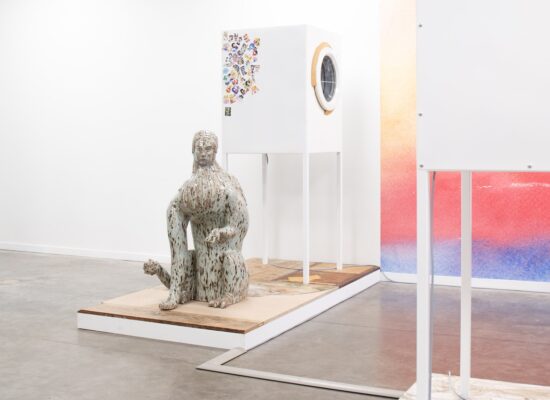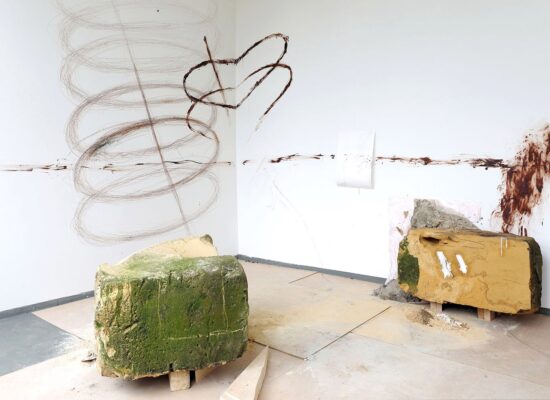How do you describe your own art practice?
I do not conceive of my practice as a succession of linear and ordered projects, but rather as an open network in which ideas circulate, contaminate one another, transform, and are constantly redefined. My work can be understood as a living archive of speculative exercises and conceptual tools that activate different systems of thought. I could describe my practice as a fragmented intertwining of knowledge and materials that connects the natural and the cultural through ambiguous encounters, where intuition, chance, and reasoning coexist and generate their own logic.
I work with a wide variety of materials, frequently combining found objects, industrial remnants, and organic elements in sculptural assemblages and installations. A central part of my approach involves provoking tensions between opposing forces or categories that enter into states of friction and ongoing negotiation.
Rather than producing closed works, I am interested in constructing open devices that question the hierarchies between the human and the non-human, the technological and the biological, the individual and the collective, or the past and the present. My pieces function as temporary configurations within a broader ecosystem of ideas and materials in constant contamination and mutation.

Puffer fish, mannequin head
Which question or theme is central in your work?
I think a central question in my work is how matter, in all its forms, contains, transforms, and transmits information. I’m fascinated by the ways in which objects, systems, and environments embody knowledge that often escapes human understanding or control. This leads me to explore themes such as entropy, agency, the archaeology of the present, and the blurred boundaries between the natural and the artificial.
At the core of this inquiry is the idea that materials are not passive but active participants in the construction of meaning. The marks of time, the traces of use, and the residues of history reveal hidden narratives that complicate our sense of order. I am constantly questioning how we relate to the material world, and how our technologies, ideologies, and everyday habits both shape and are shaped by what surrounds us. However, rather than offering clear answers, my work often opens speculative spaces where systems collapse, categories dissolve, and new ways of thinking can emerge from the fragments.

Copper, print on paper, plexiglass
What was your first experience with art?
My first experience with art happened as a child during visits to archaeological museums in Lima. I remember being fascinated by the vessels of pre-Inca cultures, but above all by the mummies, artifacts, and reconstructed skeletons displayed in glass cases. That encounter left a strong impression on me, as it revealed how objects could carry history, memory, and even traces of life across time.
My first real contact with visual art, however, did not come through museums or galleries but through reproductions. At home there were no art books, only encyclopedias, history volumes, and scientific material, since I grew up in a family of scientists. I would spend hours drawing, copying anatomical illustrations, animals, and insects from those books, and I was equally captivated by the notebooks and field journals of explorers, filled with drawings that revealed the way they observed and recorded the world.
It was only later, when I was around ten years old, that I discovered a twelve-volume encyclopedia of art history at my grandmother’s house. Out of all those volumes, I was drawn only to the first one, on Paleolithic art, and the last, on modern art from the early twentieth century up to the 1960s. Everything in between felt less compelling. What fascinated me was the contrast between the raw, primal gestures of early humans and the experimental ruptures of modern art, two extremes that opened completely different ways of thinking about images and objects, yet also contained unexpected connections that I would only begin to recognize later on.

Photocopy machine, paper, marble, book, chestnut shell, dice, wasp nest, mushroom, coral, human bone, foam
What is your greatest source of inspiration?
I do not think of inspiration as something that comes from a single source. For me, it is more like a continuous state of attention to how things relate, transform, and break down. I am deeply inspired by the material world, by the way objects deteriorate, by the logic of systems, and by the invisible forces that shape physical reality. Observing how time acts upon things, how fragments preserve traces of past functions or lost meanings, often leads me to new questions.
I am also interested in exploring and weaving together fields such as physics, archaeology, biology, and philosophy, since each of them offers different tools to think about matter, time, and processes of transformation. Yet perhaps the greatest source of inspiration comes from random and unexpected encounters with the unknown: objects or situations in daily life that disrupt all logic and generate something that resists interpretation. I find it essential to remain open to those spaces of ambiguity, where our certainties or knowledge about things become unstable and, suddenly, it becomes possible to see from another perspective.

Mixed media
What do you need in order to create your work?
What I need most is a space where intuition, research, and experimentation can coexist freely, without the pressure of a predetermined outcome. I do not begin with a fixed idea of what a work should be; rather, I need time to engage with materials, to observe how they react, transform, or interact with other elements. My process often begins with collecting, not only theoretical and visual references but also objects, images, technological remnants, and natural fragments. This constellation of elements gradually interweaves, each finding its role and place within the unfolding of a project.
I also seek a certain degree of disorientation, a rupture from habitual ways of thinking and seeing. Sometimes this arises from cross-disciplinary reading, and at other times from wandering through a city, attending to overlooked details or to the subtle behaviors of matter in unexpected contexts. It is in these moments of friction, uncertainty, and tension that new possibilities emerge, guiding the work into territories I could not have foreseen.
In the same way, I consider failure to be an essential part of the process. Meaning does not need to be imposed; it can emerge organically through the interactions between materials, gestures, and the passage of time. In this sense, the work becomes a record of discovery, a space where unpredictability is not only accepted but embraced, allowing unforeseen connections and intuitions to surface.

Centre de Création Contemporaine Olivier Debré Tours, France
What work or artist has most recently surprised you?
More than art museums or galleries, what truly stimulates and inspires me are museums of natural history, archaeology, and anthropology, where different forms of knowledge and perception intersect. One of the most striking experiences I have had recently was visiting the American Museum of Natural History in New York. There is a section where live ants build their nests inside the museum. The ants are guided through transparent tubes that run across the exhibition space and lead into glass spherical modules, where the nests evoke brain structures. Watching these insects build complex systems within an artificial environment, as they navigate between biology, architecture, and cognition, was an incredibly powerful experience.
That experience connected directly with some of the ideas I explored in my recent exhibition Fluid Minds at Max Goelitz in Berlin, where I focused on the analogies between neural networks, swarm intelligence, and technological infrastructures.
But if I have to mention an artist, it would be Pierre Huyghe. His work often transcends traditional exhibition formats and instead generates living systems that evolve over time. What I find compelling in his approach is how it allows uncertainty, decay, and interdependence to become part of the work, creating ecosystems rather than closed narratives. It is that openness, that capacity to think with and through materials, environments, and non-human agents, that continues to surprise and inspire me.

Collage on canvas mounted on wood, plexiglas




